
































































































































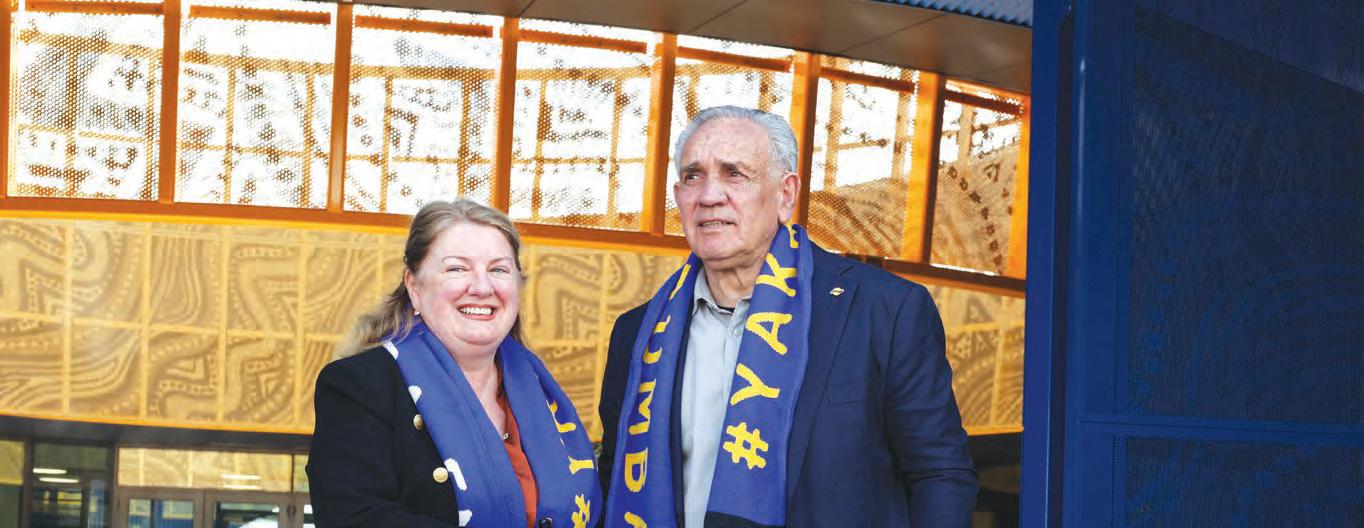
THE word ‘Munarra’ means thunder in Yorta Yorta language, and the recently opened Munarra Centre for Regional Excellence (MCRE) is expected to profoundly impact the empowerment and education pathways of both Yorta Yorta communities and the broader Goulburn Murray region.
The MCRE is a First Nations-led pathways-based university, and it is the first of its kind in Australia. The MCRE is a chance to achieve; a chance to enhance Aboriginal cultural identity, expression and celebration; grow in our leadership; improve our health; build our education; enhance our employment options; and move towards equitable social inclusion and reconciliation.
Munarra has an interdisciplinary teaching focus on sports science, engineering, allied health services, renewables, trades, early childhood, community services, nursing, agriculture, cyber security, cultural identity and entrepreneurship.
The project is a partnership between Rumbalara Football Netball Club, Kaiela Institute, University of Melbourne and Greater Shepparton City Council, and is supported by the Victorian Government. The project will work towards creating education and employment pathways for Indigenous and non-
Indigenous communities. It will combine education, culture, the arts and sport to create healthy people, healthy communities and the leaders of tomorrow.
It has been established as a ‘business of aspiration and optimism’, with an ‘invincible spirit’ as its guiding principle, partnering with complementary organisations, service, programs and social enterprises.
The Munarra Centre is delivered by a consortium of partners, led by Munarra Limited, a not-for-profit incorporation, overseen by an Aboriginal-led board of directors. Munarra Limited manage the day-to-day operations of the Centre.
The state-of-the-art education building will support students to achieve vocational and tertiary qualifications, build leaders of tomorrow and develop young people with skills to support the region and the nation. The unique landscape
Message from Travis Morgan, Munarra Limited chair
THIS moment’s been in play for more than six years, since we received funding from the Victorian Government and I’d like to acknowledge Premier Andrews for his support then to afford us this opportunity to build this great infrastructure. This infrastructure will not just benefit the Shepparton community, but the region, the state and the nation as well. Also, we are strengthening our partnerships across the ditch in Whakatane with Te Whare Wānanga o Awanuiārangi (New Zealand/Aotearoa).
I’d like to acknowledge the State Government and the University of Melbourne for coming on board and partnering with us here on Yorta Yorta Country, which has been a partnership for the last 20 years working with the School of Rural Health and the Academy of Sports, Health & Education (ASHE), which over the last 20 years has put through about 1,000 students. These students have got qualifications and gone on to work and contribute to this community and state, which is a great achievement.
The Munarra Centre gives us another opportunity to practice our inherent rights
here on country about welcoming people in and hosting people of our country and making sure that we are looking after country and looking after people, which we’ve done for thousands of years.
I’d also like to acknowledge the Munarra Board. Uncle Paul Briggs, Josh Atkinson, Milton Nomikoudis, Barry Judd and Aunty Jan Muir, as well as past board members, for their contributions over the last four to five years.
I’d also like to thank and acknowledge Tiriki Onus and Inala Cooper for the work they’ve done. This building has been a lot of work in play in terms of not just this board, but also
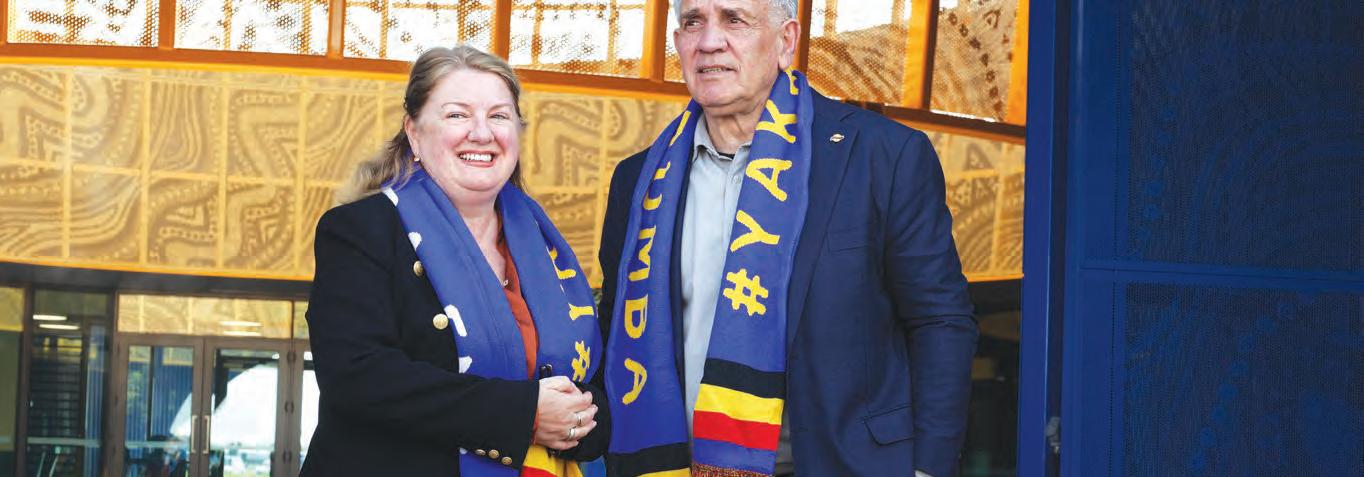

7, 2024
and culturally significant landscaping and architectural design provide welcoming spaces for students, Elders and the broader community to gather.
Munarra will create economic opportunities and career pathways for both Indigenous and non-Indigenous people through sports, health education and research and the celebration of learning, community and culture.
The first stage of construction brings the education campus to life. Future stages of development include upgrades to the Rumbalara Football Netball Club, the development of a Regional Centre of Sporting Excellence, accommodation, health and wellbeing services and early childhood education.
Munarra Limited board members:
Travis Morgan, chairperson
Paul Briggs AO, deputy chair
Jan Muir, board member
Prof. Barry Judd, board member
Milton Nomikoudis, board member
the Rumbalara Football Netball Club, Kaiela Institute, University of Melbourne, Latrobe University and the broader community.
The design – from the building to the landscape – has all been planned with community. With engagement happening over 12 months, talking to over 1,000 people – what they would like to see from a building like Munarra. As you’re walking through the Centre, you’ll see key aspects of art, culture and landscape from broad range of Yorta Yorta country – from the Warby Ranges with the rocks to the Barmah National Park with the wetlands. These elements have all been put into this building. It showcases Yorta Yorta culture and people to the region, to the nation and internationally.
I’m really proud to present Munarra to the community. This is another fantastic infrastructure project that adds onto
Josh Atkinson, board member
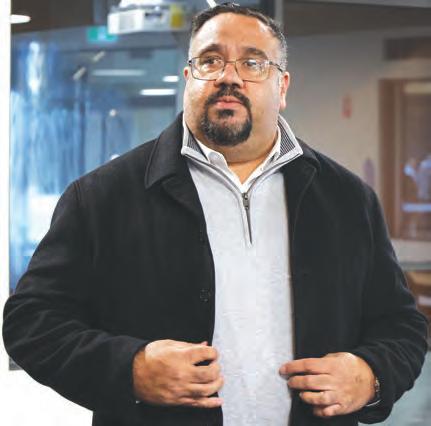
Rumbalara Aboriginal Co-Operative, Njernda Aboriginal Co-Op, and Rumbalara Football Netball Club. These are the institutions that have come along to support community and support the region. Thank you.
















and something we can all be proud of
It’s absolutely


THE First Nations-led educational centre, the Munarra Centre for Regional Excellence, is a nation leading initiative addressing parity and placing First Nations Australians at the forefront of higher education.
Munarra, which means thunder in Yorta Yorta language, resonates with the Centre’s aspiration to significantly impact the empowerment and education pathways of Yorta Yorta communities and broader Goulburn Murray region.
The state-of-the-art building incorporates Aboriginal knowledge into its design and programs, symbolising decades of efforts to place First Nations at the forefront of higher education. The project involves a partnership between the Victorian Government with an investment of $30.2M, Rumbalara Football Netball Club, the Kaiela Institute and the University of Melbourne, which contributed $6.65M.
Professor Barry Judd, deputy vice-chancellor (Indigenous) at the University of Melbourne, said, “Munarra represents much more than a physical space; it is laying the foundation for a future where First Nations Australians’ history, culture, and potential are not just acknowledged, but integral to our nation’s
programs. This is about true parity and prosperity for all.”
"It's absolutely exciting. I have not seen a centre like this anywhere else in Australia and rarely anywhere around the world,” Professor Judd said. He also highlighted that the development of the Centre in the region addresses the tyranny of distance when it comes to education.
"People who live in regional and remote Australia, and First Nations people make up a significant component of that population, are geographically disadvantaged at all levels of education,” Professor Judd explained. “To have a facility like this that links students based here in this region with the world is so important, and the technology allows that to happen.
“The classrooms in this facility can, in a literal sense, operate as global classrooms. They can, through the university's IT system, link with classrooms in Melbourne, in other parts of Australia, potentially with our First Nations partners in northeast


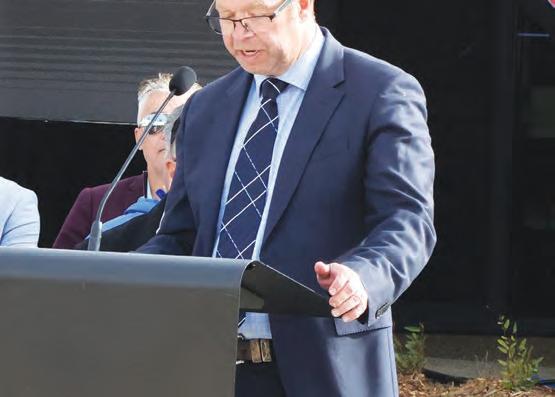
Arnhem Land, for example, but also with the world.
“We also have growing linkages here with people in Aotearoa, New Zealand. So, it's extremely important that students don't need to move away from home to get a quality post-secondary education, and they can do it all here."
Professor Judd said, "Education will form a vital part of the excellence that the Munarra Centre will bring to the region. Munarra will also serve the educational needs and build the educational profile of the region in other innovative ways, as a research hub that will support industry and community research, as an incubator for ideas that will bring together champions of the Goulburn Murray Regional Prosperity Plan and other enterprises to plan and enact growth of this wonderful region, and as a place of learning to build the appreciation of all the region's population on the beauty, ingenuity, and depth of Yorta Yorta culture and practices."



THE demand for skilled professionals is on the rise. Increased access to education is ensuring that our region has the talent it needs to thrive. The Academy of Sport, Health and Education (ASHE) was birthed 20 years ago as an initiative from Rumbalara Football Netball Club (RFNC) and the University of Melbourne to improve education, health and employment outcomes for Indigenous people in the region.
ASHE is a First Nations-led education institution which focusses on sport, health and education. While many of its students are Indigenous, around 20 to 30 per cent are not.
Beginning in 2004 with just six students, and today catering for approximately 119, ASHE has been instrumental in improving outcomes and contributing to workforce and skills shortages in the region, producing over 1,000 ready-to-work graduates from the program across a range of disciplines.
The current course offerings available at ASHE are:
• Victorian Pathway Certificate (GOTAFE) - Years 11 & 12
• Cert III in Early Childhood (PARTNERS IN TRAINING)
• Cert IV in Community Services Alcohol and Other Drugs (PARTNERS IN TRAINING)
• Cert IV in Community Services (PARTNERS IN TRAINING)
• Diploma of Community Services (PARTNERS IN TRAINING)
• Diploma of Alcohol and Other Drugs & Mental Health (PARTNERS IN TRAINING)
• Diploma of Nursing (GOTAFE)
• Bachelor of Nursing (LATROBE UNIVERSITY)

Over the next 12 months ASHE will transition in name to the Munarra Academy, as part of the evolution of the program at the Munarra Centre for Regional Excellence. ASHE will





Join a supportive community at GOTAFE, where the Koorie Unit is dedicated to your success. With personalised support, in-class assistance, and a dedicated space at our Shepparton campus, t he Koorie Un it a re here to guide you every step of the wa y. Explore our partnership with Ganbina for enhanced vocational education and training. Embrace new opportunities and unlock your future with GOTAFE.
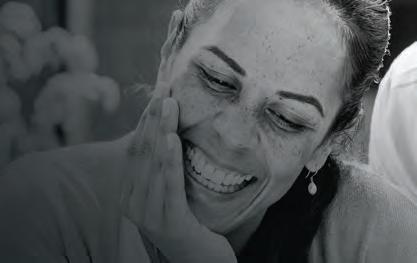

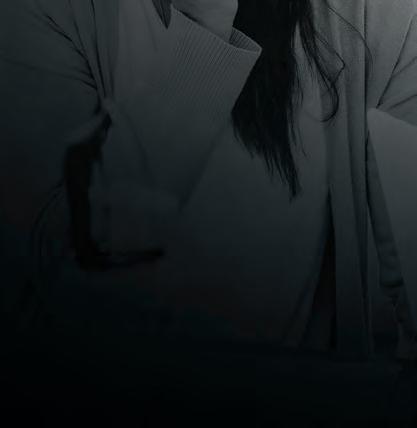





also look at increasing these educational offerings in 2025, including partnership with more education providers. To learn more about ASHE, visit https://ashe.unimelb.edu.au/

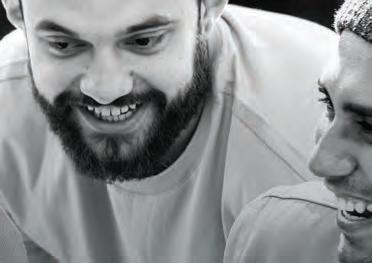


















The walk is a walk to the future
THE grand opening of the Munarra Centre for Regional Excellence (MCRE) on August 7, 2024, marked a momentous milestone in both the history of our region and the nation. As the first of its kind in Australia, the MCRE represents a significant leap forward in placing First Nations peoples at the forefront of higher education, fostering shared prosperity across our community.
The celebration began at the Rumbalara Football Netball Club (RFNC), where Minister for Treaty and First Peoples, Natalie Hutchins, announced the removal of the mortgage on the RFNC land to pave the way for its future expansion. The opening ceremony featured Indigenous leaders, performers, and speakers, who led a powerful smoking ceremony. RFNC President Josh Atkinson reflected on the club’s rich history, followed by a ceremonial walk towards the MCRE.
“The walk is a walk to the future. Crossing that blue bridge symbolises the deep connection between the history of
the Rumbalara Football Netball Club, the journey of the Munarra Centre for Regional Excellence, and the future we envision for our people, rooted in education and Indigenous knowledge,” said Uncle Paul Briggs AO, Yorta Yorta Elder and Kaiela Institute executive chairperson.
Uncle Paul emphasised that the MCRE is not just a centre for education but also a beacon for the reclamation of language, culture, and ceremonial practices, alongside Western education across all levels—tertiary, secondary, and primary.
“This vision secures our future,” he said. “Standing on this ground, surrounded by
the vibrant energy of our youth, we walk across the bridge towards a brighter future for our region and our people, opening what will become a cornerstone for our community’s growth.”
The MCRE and RFNC are now symbolically united, connected by the iconic blue bridge adorned with the word “Cummeragunja,” a nod to the historic Cummeragunja Walk Off—a pivotal moment in Indigenous history that sparked a nationwide movement for Aboriginal rights. Today, that walk continues, not just in memory but in action, as First Nations people move toward a future of
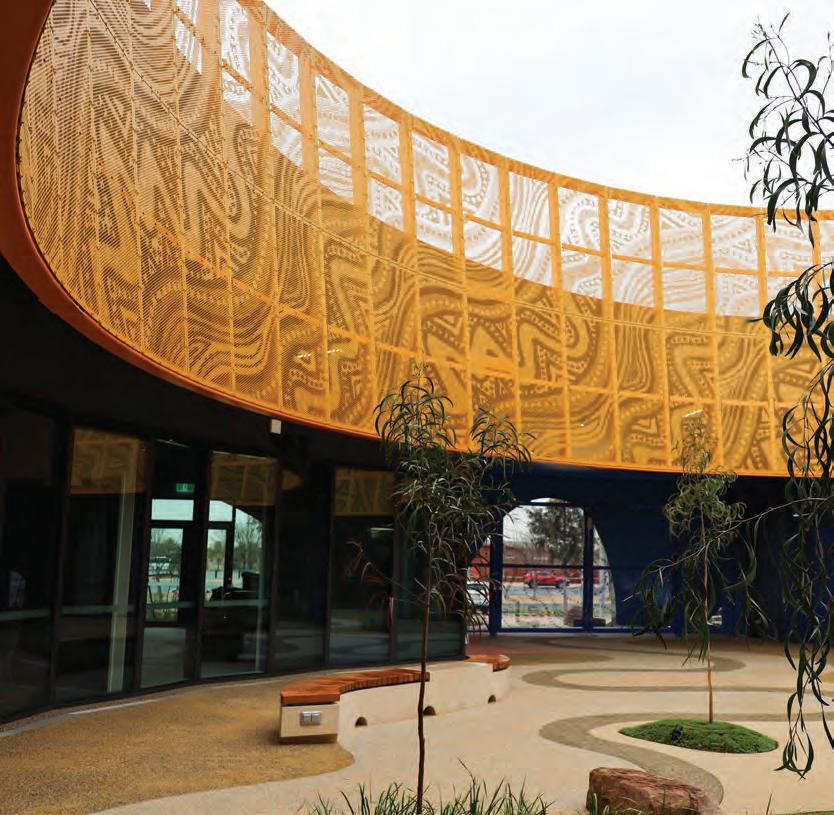
opportunity, self-determination, and growth, with the MCRE at the heart of this journey.
For First Nations Australians, accessing education has been complex and challenging, shaped by the broader history of colonisation, policies of exclusion, and ongoing struggles for recognition and equity. In the face of this history, the MCRE stands as a pillar of hope for a brighter future.
“The Munarra Centre for Regional Excellence is supported by Rumbalara Co-Operative, Njernda Cooperatives, Kaiela Arts, and Yorta Yorta Nation,” Uncle Paul added. “These institutions form the infrastructure that will sustain the Centre’s mission, alongside the Goulburn Murray, as we pursue economic resilience.”

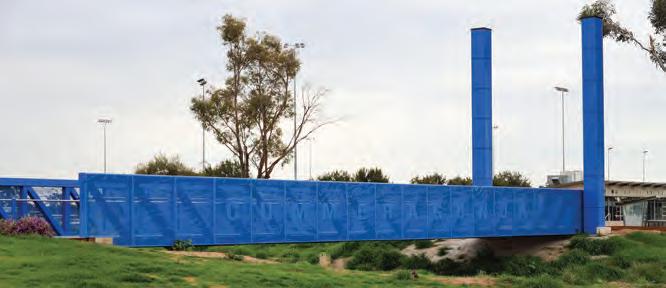


You need culture, and you need your connection to culture to have a sense of who you are to fulfil your educational journey
WITH sports participating at its core, the Academy of Sports, Health and Education, better known as ASHE, is working to improve Aboriginal equality and overall life outcomes, providing accessible, culturally-relevant education, training, health and employment opportunities and outcomes primarily – but not exclusively – to First Nations people.
ASHE students relocated from their Nixon Street campus to the new Munarra Centre for Regional Excellence (MCRE) in Term 3 this year. Heidi Knowles, who is manager of operations and student success at ASHE, as well as a past student and current acting director, said first reactions to the brand-new campus were very positive.
"It's such an amazing, magnificent building. For them, you know, we really don't have anything so amazing and to be a part of history and to have a magnificent building like this, it's starting to give them a sense of belonging,” she said.
"Culture plays a big part in education, and especially in an Indigenous person's life. You need culture, and you need your connection to culture to have a sense of who you are to fulfil your educational journey."
The transition has fostered a sense of belonging and provided students and staff with improved facilities, including culturally significant designs and a child-friendly room for students with children. These state-of-the-art learning facilities cater to both high school and mature aged students, breaking

barriers that limit participation in education.
The holistic approach of ASHE addresses various aspects of students' lives, enhancing their engagement and success. The new campus offers significantly better amenities compared to the old Nixon Street Campus, including more classrooms and upgraded communal spaces. Knowles hopes the new centre will attract more students, both Indigenous and non-Indigenous, and contribute to their educational and employment journey.
Further, technology is embedded in all classrooms, giving students access to courses from around the country and the world, allowing them to participate in learning opportunities and connect with a global learning community.
Ms Knowles is a testament to the power of what opportunity, and particularly ASHE’s unique model, can achieve.
A recovered ice user, she has been clean for nine years and approached ASHE in 2018 hoping to give back and to the community and enhance her opportunities.
After starting a course in community services, Ms Knowles was awarded Student of the Year and was offered casual

With over 20 years experience in the concreting industryJoseph and his team will be sure to give you all the advice and knowledge required to complete your concrete project to the highest standard.
Our Services:
•Commercial Slabs
•Factory Floors
•Cool Stores
•Architectural and In-situ
•Concrete Hardscapes
•Stencil
•Concrete Roadways
•Sub-division Footpaths

•Decorative Concrete - including Exposed Aggregate







•Concrete Cutting, Demolition and Removal
















employment with the Year 11 and 12 students and Cert IV Community Service students.
“They were that impressed with me they asked if I was interested in doing my training and assessment.” Ms Knowles went on to teach Community Services students for two years in addition to working as a coordinator at ASHE part time before being offered the ASHE manager role.
“Places like this, we need them for our community,” said Ms Knowles. “Because it gives the community a second chance if they need it, and I’m a product of that.”
"Hopefully, we’ll have even more Indigenous and nonIndigenous people come here and be a part of the Munarra Centre and study. That way, we can get more of our community out into employment and on their educational journey."
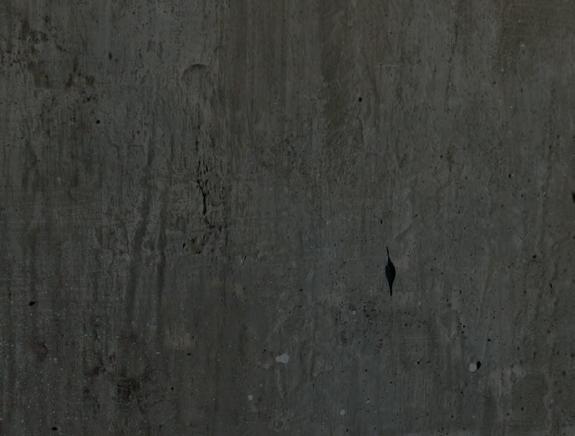

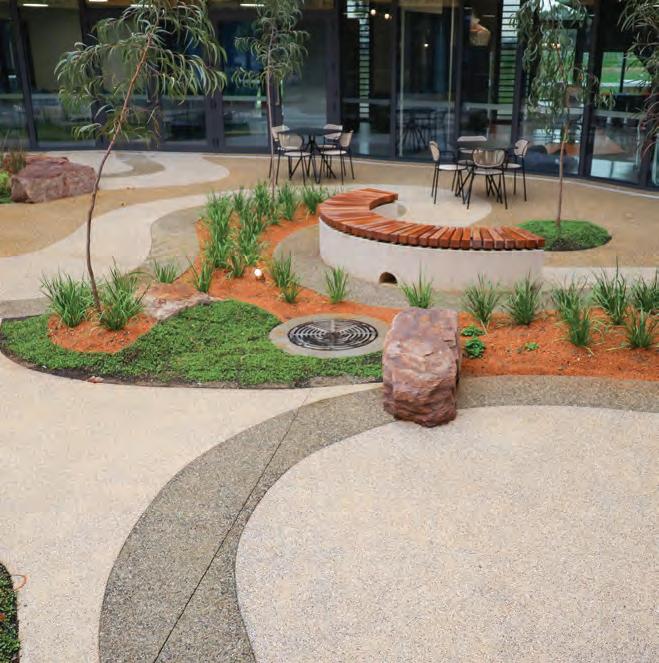

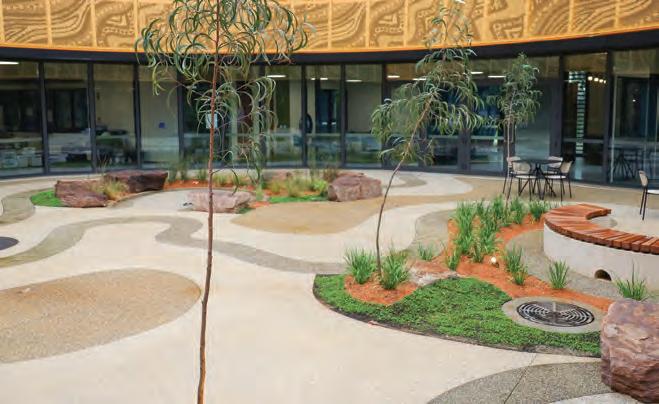


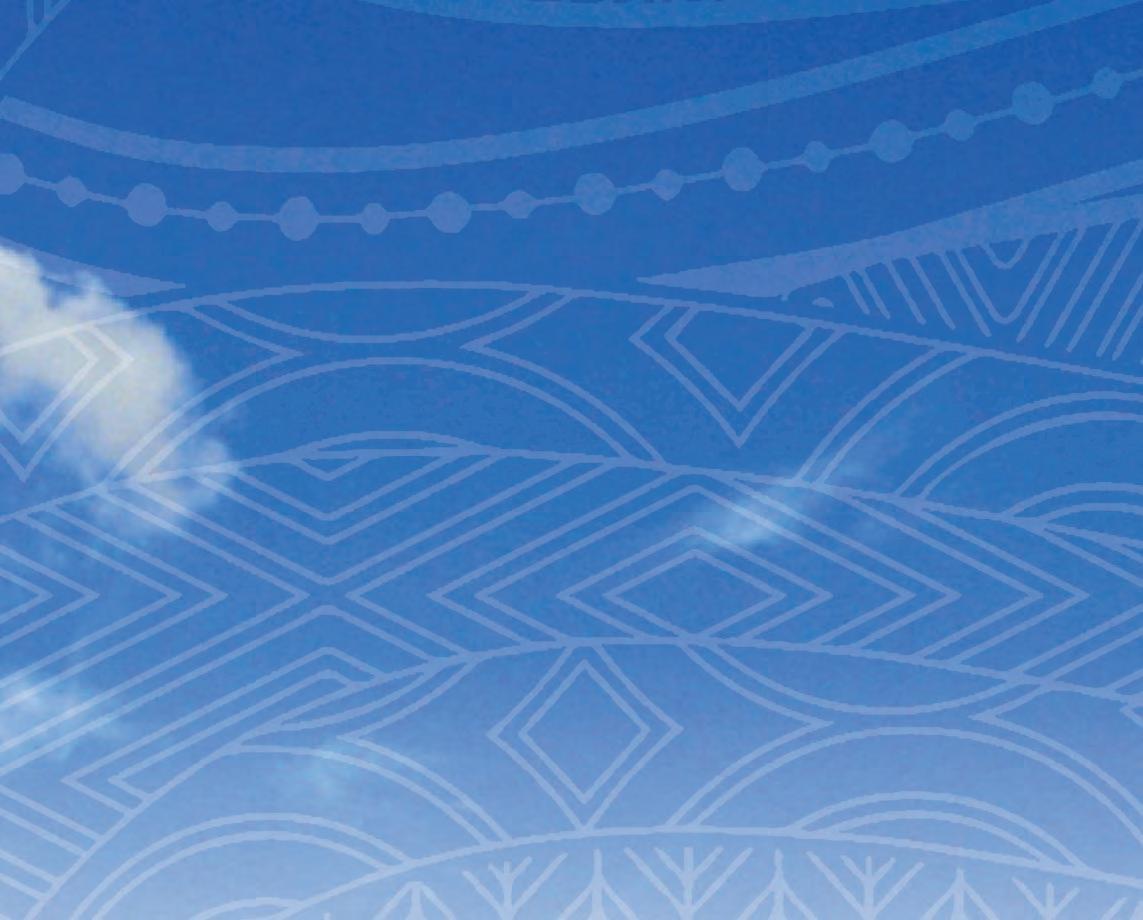

Rumbalara Football Netball Club & Munarra Centre for Regional Excellence

Rumbalara Football Netball Club is a proud and strong Aboriginal led sporting club dedicated to strengthening the community and bringing families together through strong, vibrant leadership. It is a place that people of all ages and backgrounds can call their own.






TACKLING disadvantage and opening new opportunities to the most vulnerable, so that everyone can participate on a level playing field and contribute to the collective wealth of the region is central to the Goulburn Murray Regional Prosperity Plan.
Driven by the Kaiela Institute, a First Nations-led analysis and policy think tank, with support from education partners University of Melbourne, La Trobe University and GOTAFE, the Plan seeks to build a thriving First Nations economy to generate new income, opportunities and shared prosperity for the benefit of all people.
“In Shepparton we have been relentless in our desire to make radical changes to extreme disadvantage,” said Paul Briggs AO, executive chairman of Kaiela Institute. “Designed by the region, for the region, the Plan marks an historical turning point. it is a watershed moment for our region that promises to restore a thriving First Nations economy. This, in turn will create new productivity and prosperity for everyone.”
“By working in close collaboration with Yorta Yorta and First Nations people, the region can create a thriving economy with circular economic flows building shared prosperity and regional growth.”
The Munarra Centre for Regional Excellence is a key
annum through economic stimulation; provided by employment and business

Designed by the region, for the region, the Plan marks an historical turning point
enabler of the 15-year Plan, aiming to deliver parity on life expectancy and quality of life for Yorta Yorta people, whilst generating an additional $150M gross regional product (GRP) per annum through economic stimulation; provided by employment and business growth for both established and upcoming First Nations-led business initiatives.
The Plan flips how we view and understand the place and role of First Nations people in the regional economy from a prevailing deficit model to a positive and contributory model. Taking responsibility, the region will share in the value generated from a place-based circular economy model, whilst also fostering understanding of, and respect for, the social, cultural and economic contributions of Yorta Yorta and First Nations people.


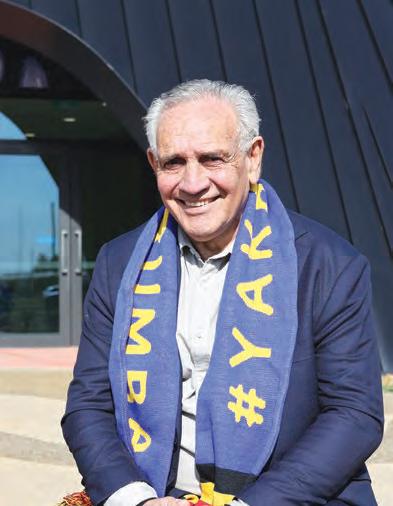
Mr Mohamed, a Gooreng Gooreng man from Bundaberg in Queensland, is Australia's dedicated First Nations representative for international engagement. He has a strong connection to community, having worked in First Nations health, social justice and reconciliation over decades, as well as in government and the corporate sector.
As a former CEO of Rumbalara Aboriginal Cooperative (RAC) and Director of the Academy of Sport Health and Education (ASHE), a partnership between Rumbalara Football Netball Club (RFNC), University of Melbourne and GOTAFE, he is a stand-out example of the region’s investment in First Nations leadership.
In his address, Mr Mohamed spoke of the deep and longstanding personal connection he has with the region and its First Nations-led institutions, and drew on the aims and work of his Office of First Nations International Engagement at the Department of Foreign Affairs and Trade, to drive a First Nations approach to foreign policy, including trade and investment, and development, in partnership with Aboriginal and Torres Strait Islander people.
Mr Mohamed is working to identify new









JUSTIN Mohamed, Australia’s inaugural Ambassador for First Nations People, delivered the Dungala Kaiela Oration on Yorta Yorta Country in Shepparton in July, alongside local Yorta Yorta and other First Nations communities, and Goulburn Valley community members.
areas of cooperation between First Nations communities and Australia’s international partners, including in intellectual property and exports, climate change, human rights, tourism and development.
Kaiela Institute (KI) executive director Paul Briggs AO said it was significant that the 2024 Oration would be joined by Mr Mohamad given the Institute’s efforts to build a productive and prosperous future of the Goulburn Murray community.
“We look forward to his advocacy at national and international levels in his new role as the inaugural Ambassador for First Nations people. We are confident this will build momentum for delivering the innovative Goulburn Murray Regional Prosperity and Productivity Plan, a wholeof-region partnership to recognise and deliver our right to a thriving First Nations economy,” Paul Briggs said.
University of Melbourne Vice-Chancellor Professor Duncan Maskell said the University’s enduring commitment and partnership with the KI and the Goulburn Valley was emphasised by the annual Oration, now in its 16th year.
A recording of Mr Mohamed's Oration can be viewed online at https://bit.ly/4eBB8sj























For too long, Yorta Yorta and First Nations people have been expected to step into the Western world in order to prosper. From this position of a lack of perceived value, everyone in the community loses. Yorta Yorta people see the world differently.


Rather than seeing Yorta Yorta and First Nations as people that mainstream society needs to give to, the Goulburn Murray Regional Prosperity Plan (the Plan) provides a space so that the region can start to see they are people who have something to give that is of great value. This Plan provides a place-based investment model that, if successfully executed, has the potential to change the social and cultural fabric of our nation.
While this 15 year Plan is ambitious, the Goulburn Murray region is ready. A strong foundation of local Indigenous infrastructure is mobilised for investment to ensure that Yorta Yorta and First Nations people are part of the future growth of gross regional product (GRP) in the region. A governance structure has been developed that will allow ‘learning as you go’ and the flexibility to adapt as priorities change over time. The monitoring and evaluation framework will provide a place-based approach to the Government’s Closing the Gap agenda.




Critically, the right stakeholders across the region are committed for the long term to shared responsibility to restoring access to the regional economy for Yorta Yorta and other First Nations people. Through the creation of a circular economy, where local Yorta Yorta and First Nations people can contribute to, and then benefit from, the growth of the wider economy, the Goulburn Murray region has an opportunity to lead the nation on how to create a shared prosperity model that tangibly benefits everyone.




The vision of this Plan is to generate an additional $150m GRP per annum by 2036 for the Goulburn Murray region through the economic inclusion, prosperity and shared value of Yorta Yorta and First Nations people. The activation of the strategic themes in this Plan will provide significant benefits, some of which are illustrated below.







Additional $150m GRP per annum by 2036 for the Goulburn Murray region through the inclusion, prosperity and shared value of First Nations people.

















By working together, the region will share in the value and prosperity that is generated from a place-based, productivitydriven investment and re-investment model. This will build understanding of, and respect for, the social, cultural and economic contribution of Yorta Yorta and First Nations people.


Established in 2004, the Academy of Sport, Health & Education is an Indigenous focused program with a difference. ASHE, created in partnership between Rumbalara Football Netball Club and The University of Melbourne, provides pathways to further education and employment for young and mature-aged students, learning in a culturally safe and supported environment.

To improve Aboriginal equality and overall life outcomes using a distinctly unique community development and whole-of-life support model, providing accessible, culturally-relevant education, training, health and employment opportunities and outcomes to primarily – but not exclusively – Aboriginal people.
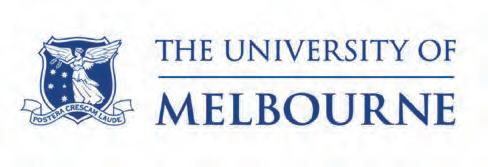

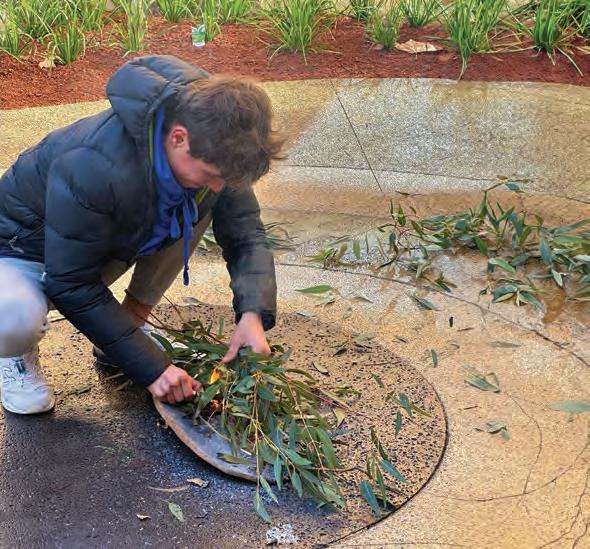
ASHE serves the needs of all people in the community, not only those with talent in sport. The curriculum is cross-sectoral, focusing on individual needs, the identification of personal goals and direct links to
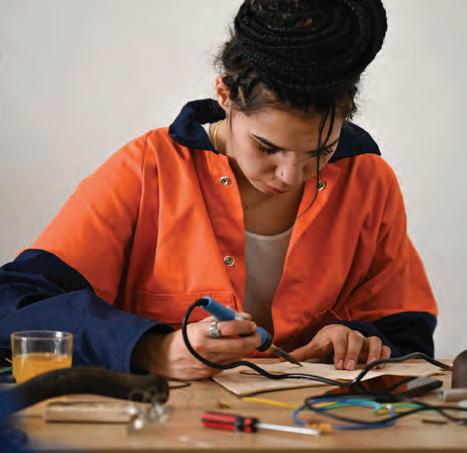
employment and other education opportunities.
The partnership between RFNC and the University of Melbourne is a robust and powerful one. RFNC is at the hub of community leadership, with a proven record of delivering community programs. The University of Melbourne brings its academic expertise,

ASHE uses sporting participation to undertake education and training within a culturally appropriate environment, particularly for Indigenous students. Students are supported to follow their interests and talents beyond sport, however. “We’re about more than just sport, we see talents in many areas and our aim is to capture what each student wants to do and what is best for them,” explained Seldan. “The biggest outcome is to keep our students engaged by providing one-on-one learning experiences, cultural


organisational capacity and longterm commitment to engagement with the region through its Goulburn Valley Initiative. This partnership, in collaboration with Goulburn Oven’s TAFE, LaTrobe University, Partners in Training and its culturally friendly and flexible programs, forms the foundation of ASHE.


education, employment opportunities and pathways, while also improving health and wellbeing outcomes. “When students graduate, we don’t just let them go, we work on pathways for each individual student for employment or future studies and support them until they start the next chapter,” Seldan said. With sport participation at its core, ASHE is working to improve Aboriginal equality and overall life outcomes, providing accessible, culturally-relevant education, training, health and employment opportunities and outcomes to primarily – but not exclusively – Aboriginal people.



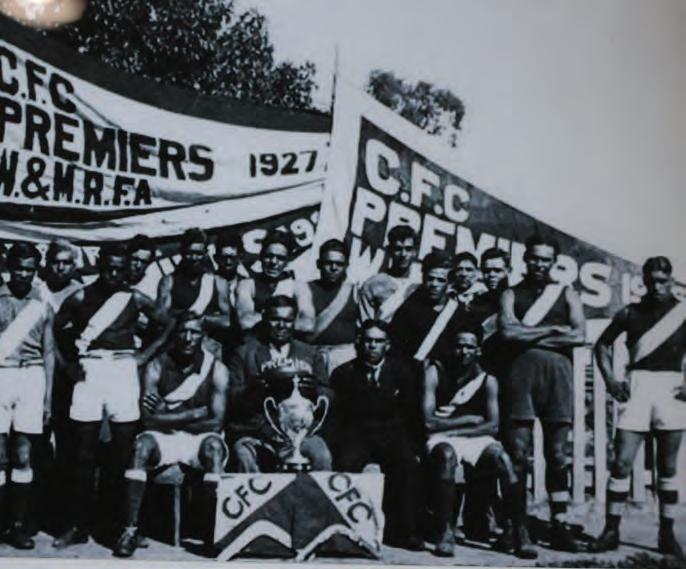
INVINCIBLE SPIRIT... Cummeragunja Football Team (1927). Coach Tom Dunnolly is pictured in the middle behind the premiership trophy. Between 1926 and 1931, Cummeragunja won the premiership five times in six seasons in the Western Riding and Moira Association and became known as “The Invincibles.” Photo: Supplied
THE PAGE... Cummeragunja Station was established in 1888 on the NSW side of the Murray (Dungala) River. Many residents had relocated from Maloga Mission, tired of its strict religious control. A er petitioning the Governor, land for Cummeragunja was reserved two years later. The station thrived until 1915, when the NSW Aboriginal Protection Board took control, imposing restrictive conditions. Residents faced poor rations, children were removed for forced labour, and funds were seized by the Board. By the 1930s, deteriorating conditions and illness like tuberculosis plagued the community, leading to a mass strike in 1939, the first by First Nations people. Photos: Supplied
DURING the early years of colonisation, First Nations Australians were largely excluded from formal education systems established by European settlers. Colonial authorities and missionaries often saw Indigenous people as incapable of benefiting from education. The few educational opportunities that did exist were typically geared towards assimilation, aiming to “civilise” First Nations children by erasing their cultural identities and languages.
IN the 19th and early 20th centuries, many First Nations children were removed from their families and placed in missions or reserves, where missionaries provided education. However, this education was often basic and aimed at training children for lowskilled labour rather than providing a comprehensive or empowering education.

This centre is a significant step towards fostering a more cohesive and vibrant community, where everyone can thrive together!

I'm truly excited about the positive impact the Munarra Centre of Regional Excellence will bring to our community! Its focus on sustainability will not only promote educational practices but also inspire future generations in elite sport and health. Additionally, the commitment to inclusion ensures that everyone, regardless of background or ability, will have access to resources and opportunities.
Being part of the construction through my company, Atkinson Electrical, has been an incredible experience. We take pride in contributing to a project that embodies innovation and community spirit.




FIRST Nations Australians have faced a complex path to accessing education, hindered by colonisation, policies of exclusion and ongoing struggles for recognition and equity. The Munarra Centre for Regional Excellence is set to transform outcomes and create new opportunities for both Indigenous and non-Indigenous peoples.
THE policy of forcibly removing First Nations children from their families, now known as the Stolen Generations, further disrupted access to education for many Indigenous Australians. These children were placed in institutions or with non-Indigenous families, where they often faced neglect, abuse, and a lack of proper education. The trauma of this period had lasting effects on individuals and communities, including a deep mistrust of formal education systems.











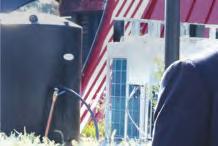









EXCELLENCE… Pictured are Munarra Limited interim CEO Tom O’Reilly and chairperson Travis Morgan as the Munarra Centre neared practical completion earlier this year. Photo: Deanne Je ers

CULTURAL EDUCATION… Programs like the Munarra Centre and ASHE aim to empower First Nations students through education grounded in cultural and community needs. Pictured top and bottom le are ASHE students Brogan McGee and Jorja Kirby participating in Greater Shepparton Lighthouse Foundation’s Pit Stop Program. Le to right at ASHE Fest are RUMBAWOMAN Dakoda Woodscarpio and ASHEMAN Djarmbi Collyer with a student. Photos: Amy De Paoloa
A KEY aspect of improving educational outcomes for First Nations Australians has been the recognition of the importance of culturally relevant education. This includes incorporating Indigenous knowledge, languages, and perspectives into the curriculum and creating supportive environments that respect and celebrate First Nations identity. Programs like the Munarra Centre for Regional Excellence reflect this approach, aiming to empower First Nations students through education that is grounded in their cultural heritage and community needs.
AFTER World War II, there was a slow shift in attitudes towards First Nations education. Advocacy from First Nations leaders, such as William Cooper and Doug Nicholls, began to challenge the status quo, demanding equal rights and access to education. The 1967 Referendum, which allowed First Nations people to be counted in the census and gave the federal government the power to make laws for Indigenous Australians, marked a significant turning point.
THE 1970s saw the rise of the Aboriginal rights movement and the principle of self-determination, which included calls for greater control over education. The establishment of Aboriginal-run schools, the introduction of Indigenous studies in universities, and the development of policies aimed at improving educational outcomes for First Nations students were important steps forward.
Today, there are more opportunities for First Nations Australians to access education at all levels. Initiatives such as scholarships and targeted support services have helped increase participation and retention rates and universities now offer a range of First Nations studies programs and have established centres for Indigenous education and research. However, significant challenges remain. First Nations students still face barriers to education and gaps in educational attainment between Indigenous and nonIndigenous Nations Australians persists, particularly in remote and rural areas.

Chris Johnson and the SKS Indigenous Technologies team take this special opportunity to congratulate everyone involved in Australia’s first First Nations-led pathways-based university - The Munarra Centre for Regional Excellence
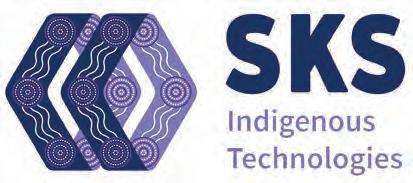









NESTLED within the Shepparton Sports Precinct, the Munarra Centre for Regional Excellence (MCRE) stands as a vibrant hub of cultural and educational significance. A striking blue bridge, bearing the word "Cummeragunja" in its intricate design, links the Centre to the Rumbalara Football Netball Club (RFNC), symbolising the deep-rooted connection to the local Indigenous heritage.
Occupying a 3,000-square-metre space on a 1.486-hectare site adjacent the Shepparton Sports Stadium off Numurkah Road in North Shepparton, the land was leased from the Greater Shepparton City Council under a 50-year peppercorn lease meaning that the MCRE is primed for future expansion.
This cutting-edge facility features four classrooms that can each accommodate 25-30 people, along with a child-friendly classroom. At its core is a central courtyard, ideal for performances and events with a capacity of 150-200 people. The Centre also includes a Yarning Room, an Elders Lounge with a replica night sky embedded in the ceiling and ambient soundproofing, a boardroom, and staff offices. A café space, intended to be utilised for teaching hospitality skills, is planned, along with leasable office space and a community meeting room.
landscaping by Bush Projects Landscape Architecture. The project was carried out by TVN On-Country, an Indigenousled construction company, reflecting the Centre’s commitment to cultural integrity and excellence.
It’s truly special to open it for the community
Designed by ARM Architecture, the MCRE showcases an Aboriginal flag-inspired roof and culturally significant
TVN On-Country achieved a 10.8 per cent spend with Victorian Aboriginal businesses against a mandated spend of 1.5 per cent, and 32.9 per cent of the project team were Victorian Aboriginal people, against a 15 per cent target. Notably, it included students from ASHE, who are studying at the completed MCRE.
27,267 hours of onsite construction works were completed by disadvantaged Victorians, against a 3,000-hour target and 15.9 per cent of total labour hours for apprentices and trainees was carried out by women, against a 4 per cent target. It is TV On-Country's biggest project to date, and as managing director and proud Wiradjuri man, Jebb Hutchison put it, their most significant and rewarding project. "It's truly special to open it for the community," Jebb said, reflecting on the project's significance.





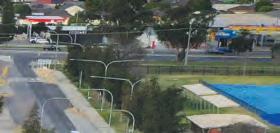





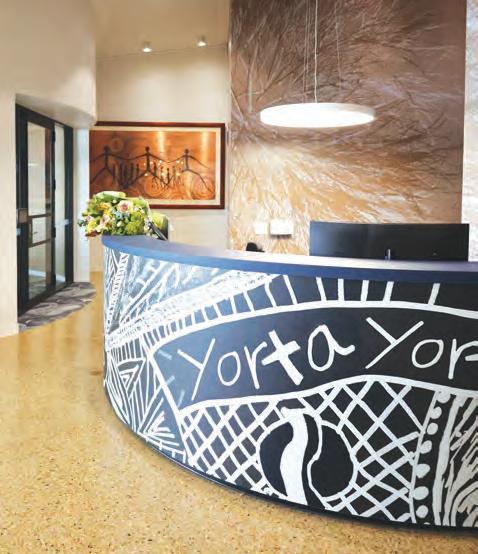
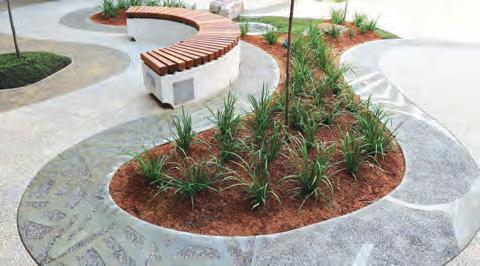


















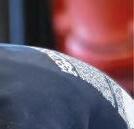













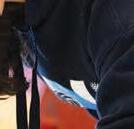














Together with wonderful artists and community we created a meaningful story that we could see ourselves and our identity in


THE Munarra Centre is more than just a striking architectural feat – it is a profound cultural beacon, meticulously designed to celebrate and integrate First Nations culture and heritage. Every aspect of the building, from its shape to its artistic details, reflects a deep commitment to cultural expression and community connection.
The building is shaped like the Aboriginal flag, best viewed from above. The courtyard is positioned in the centre, opened to the sky. This choice not only honours the flag's symbolism of unity and identity but also embeds cultural significance into the very structure of the Centre, with all areas having access to the outside world and to Country.
Arches shaped like emu eggs further deepen this connection. Emu eggs are emblematic of nurturing and protection, symbolising the Centre’s role in supporting and guiding the younger generation. This theme of care and growth is echoed throughout the building’s design, creating a welcoming space for all who enter.
Belinda Briggs, Kaiela Arts vice president and Nanyak adviser, said, “The artwork before you, wrapping around and woven throughout is a representation of who we are, where we come from and informing our visions of the future.
“Together with wonderful artists and community we created a meaningful story that we could see ourselves and our identity in.
“Kaiela Arts had the honour to work with artists Glennys Briggs, Norm Stewart and Suzanne Atkinson, in collaboration

SIGNIFICANT WORKS… The MCRE is grounded in First Nations connections, stories and knowledge; it is a place to uphold values and celebrate their identities and culture. Phase one of the commission was developed to create the building cladding and screening elements for the central courtyard, which involved discussions between Yorta Yorta artists, Kaiela Arts and Spacecra to share insights about the artworks and practice. Pictured in the back row are Stewart Russell (Spacecra ), Belinda Briggs (Kaiela Arts), and artist Norm Stewart. Front row: Danica Miller (Spacecra ), artists Suzanne Atkinson and Glennys Briggs, and Lyn Thorpe
with Stewart Russell and Danica Millar of Spacecraft, architects ARM Architecture and landscape architects Bush Projects Landscape Architecture to bring those things that give us our stories to life.”
Belinda explained that Aunty Glennys’ work spanning the front entrance informs us that ceremony, knowledge and spirit is here. The work depicts a bullroarer and a string bag, traditional items used in ceremonies. These elements are not merely decorative but serve as conduits for cultural transmission and knowledge, linking visitors with Aboriginal traditions.
Suzanne Atkinson’s Bull Ants speak to the might of an individual but also the strength in numbers, the resilience to endure, determination to overcome and an invincible spirit.
On the east and west ends of the building, Uncle Norm Stewart’s depiction of the blowhole at Tocumwal acts as a portal to other worlds, representing the connection to land and ancestral stories. Similarly, Uncle Norm’s Three Rivers artwork pays homage to Dungala, Kaiela and Yakoa, or Murray, Goulburn and Campaspe rivers, and draws eyes skyward, inviting respect for our waterways, and the life that they, the sun, and that ancestors, provide.


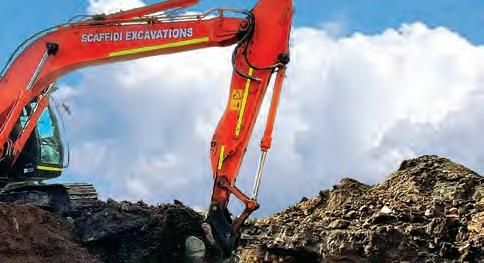









THE journey to the completed Munarra Centre for Regional Excellence has been one that has uplifted the community and in particular, First Nation Australians, from conception through construction.
The build was completed by 70 per cent First Nations-owned construction company TVN On-Country, providing a range of opportunities to First Nations peoples. Ambitious social procurement targets ensured First Nation Victorians were employed at every stage of construction, with every target exceeded.
Jebb Hutchison, the managing director, shared his emotional response to seeing the vision come to life after 18 months of hard work. Jebb said, "This is our largest build to date, a design and construct build, so, you know, big risk, a big risk for us as
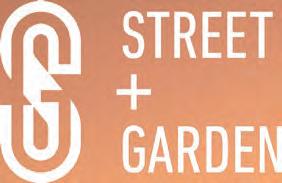
an organisation to take it on, but also a big risk for the government to award a contract
of this value to a First Nations building organisation from Albury-Wodonga, you know, the boys from the bush.”

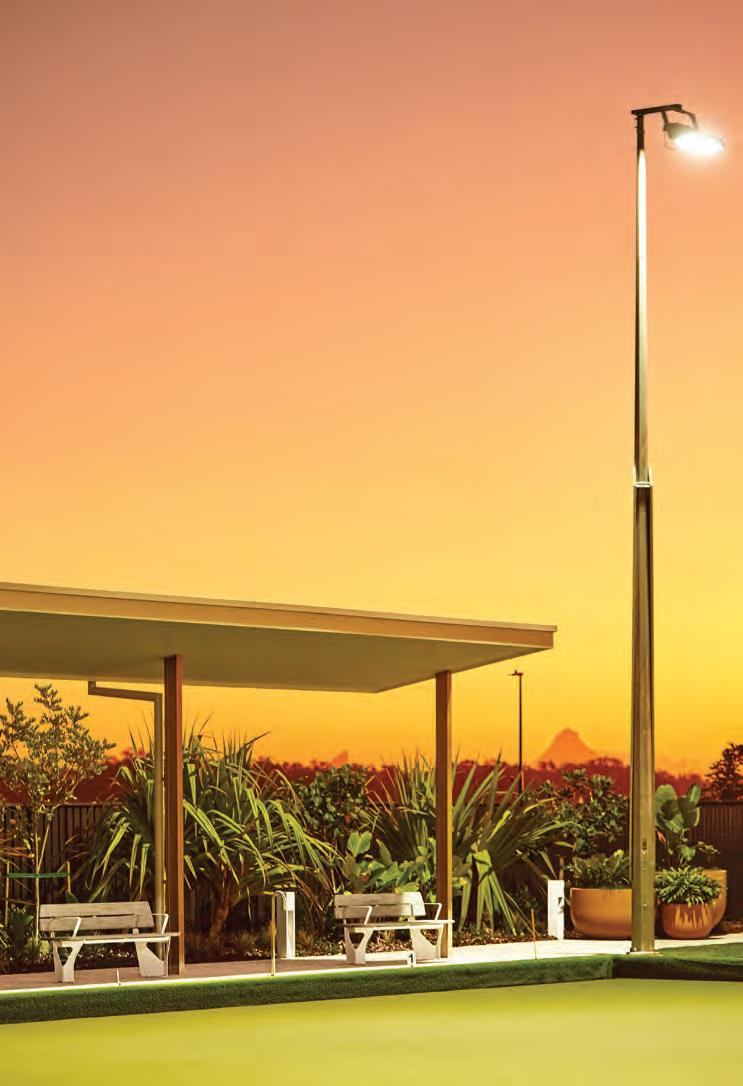
"Having a First Nations head contractor lead this project opened up the opportunities for more First Nations contractors, trades, and employment opportunities, not just with them, but with our own organisation as well. That allowed us to employ what I'll say are future leaders."
Not only were social procurement targets achieved and surpassed, but students from ASHE have also been involved in the Centre’s construction and will continue their employment with TVN On-Country, something Jebb is very proud of.
“ASHE is an amazing program and amazing organisation that just continues to turn out amazing outcomes,” said Jebb. “It’s a continuation of what’s possible when given the opportunity.”
"Part of our business philosophy is we try and provide opportunities for First Nations

The
build was completed by 70 per cent First Nations-owned company, TVN On-Country, who exceeded ambitious social procurement targets during construction.
people in particular and I'm proud we’ve achieved that. I grew up in Hillston in central New South Wales, and I understand what an opportunity can do for people because, you know, where I come from, sometimes there's a lack of opportunity."
Mr Hutchison is a proud Wiradjuri man and said his mother was the first in his family to be formally educated, something she pursued in middle age. Jebb said now the building is complete, he too looks forward to furthering his knowledge as a student at the MCRE.
Jebb extended gratitude to the supportive community, stakeholders and visionary leaders. He said, "Together we're stronger," expressing hope that the Centre will unite and benefit the entire community.
"As our culture is built on shared knowledge, we need to continue to share our knowledge so that the next generation is ready to take over the hard work we've done."

















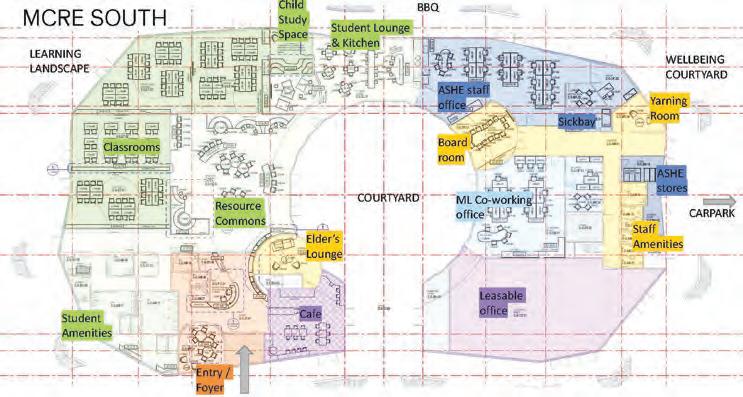







FOSTERING PROGRESS…

Pictured is associate professor Michael Donovan, La Trobe University’s pro vice-chancellor (Indigenous), and Uncle Paul Briggs AO, executive director of The Kaiela Institute. Photo: Supplied



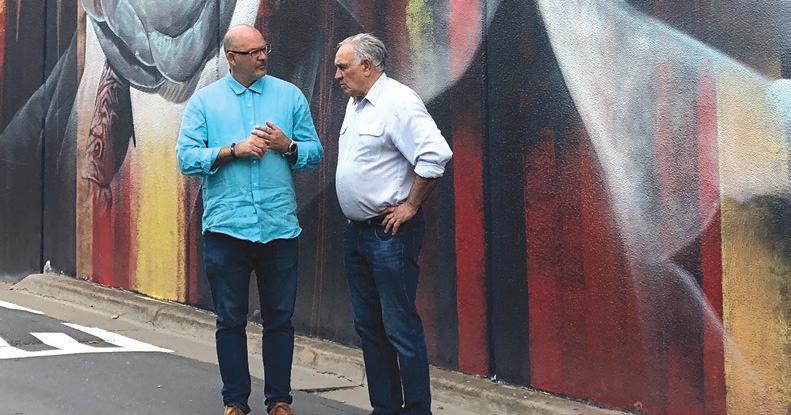
A SIGNIFICANT step toward bolstering support for First Nations people and enhancing regional higher education access, equity and opportunity was taken by La Trobe University. The University pledged over $1M in 2023 to establish a thriving partnership with Munarra Limited over the next three years.
This investment includes five new proposals among a total of seven commitments. These include scholarships for all First Nations students at the Shepparton campus, a fully funded role for student engagement, support, and recruitment, a guaranteed three-year revenue share for Munarra, and Munarra being chosen as the preferred partner for cultural awareness training for La Trobe staff.
“The commitments reflect the confidence we have in Munarra, its vision and our partnership,” said former vice-chancellor professor John Dewar AO, who finished his tenure at the beginning of 2024. He emphasised La Trobe’s commitment to investing in initiatives that will help both institutions achieve their collective ambitions.
Uncle Paul Briggs AO, executive director of The Kaiela Institute, welcomed La Trobe’s funding pledge, stating it will deliver tangible benefits to the communities they serve.
Associate professor, Michael Donovan, La Trobe University’s pro vice-chancellor (Indigenous), noted that this is an exciting development for the whole community.
Lisa McKenzie, chair of the La Trobe University Shepparton Regional Advisory Board, said the Munarra Centre will be an incredible asset that will have the capacity to transform lives.
“Munarra Limited and La Trobe share a commitment to equity and outcomes, and it will be exciting to see the benefits of this partnership unfold,” Lisa said.
This collaboration is an achievement for both organisations, following many fruitful discussions in the months prior. La Trobe University and Munarra Limited will formalise these proposed commitments into written agreements in accordance with the memorandum of understanding, which was signed on November 3, 2024.



GOTAFE celebrates the opening of the new Munarra Centre for Regional Excellence, which represents a significant step in reaffirming the region's commitment to First Nations education.
The Munarra Centre for Regional Excellence will enhance outcomes and improve participation levels in education for cohorts which have typically been underrepresented.
The Munarra Centre for Regional Excellence builds on successful student learning and support models, including The Academy of Sport Health and Education (ASHE).
ASHE has relocated to the Munarra Centre and in collaboration with La Trobe University and GOTAFE, will continue to deliver VCE, TAFE and University, emphasising the importance of accessible pathways between TAFE and university studies.
ASHE began as a partnership between Rumbalara Football Netball Club and the University of Melbourne in 2004.
ASHE started with six students and has evolved into a thriving education


PARTNERS IN EDUCATION... The Munarra Centre for Regional Excellence expands upon proven student support models, including The Academy of Sport Health and Education (ASHE). ASHE, now located in Munarra, is supported by strong partnerships with educational institutes including La Trobe University and GOTAFE, to o er VCE, TAFE and university courses. This collaboration emphasises seamless transition between di erent levels of study. Photo: Supplied
GOTAFE hopes the facility will support and increase access to education for local First Nations community members and looks forward to seeing the impact it will have in the years to come






program that offers VCE and TAFE qualifications, supporting over 1,200 students in their transition to employment or further education.
GOTAFE hopes the facility will support and increase access to education for local First Nations community members and looks forward to seeing the impact it will have in the years to come.
To learn more about GOTAFE, visit www.gotafe.vic.edu.au











Message from Paul Briggs AO, Munarra Limited deputy chair I’D like to thank everyone for joining us to celebrate such an important investment into our future and our shared future, and into our children’s future. The health and wellbeing of the next generation is a legacy that we want to be able to improve on. The strengthening of not just a vision for the future, but in building the strategy and skills to achieve it.
The Munarra Centre and Rumbalara Football Netball Club (RFNC) are powerful tools of change. Together with our allied partnerships and organisations that surround us, we are working to extract ourselves out of that crisis mode of operations. Having a vision is critical to be able to pull us out of the crisis elements of our community.
Some of the strengths that we’ve been able to achieve underpin the partnerships that will transform this region and act as a beacon of change to the rest of the nation. RFNC has really been a powerful tool for creating partnerships like the one with Melbourne University and the State Government.
I want to acknowledge the Elders present to witness the opening of the Munarra Centre. In particular people I’ve grown up with. Uncle Boydie – we talked about football and the invincible spirit of the Cummaragunja Football and Cricket teams and the championships that come off there. My dad, Les Briggs, who was born in 1896. He talked about those champion teams and champion runners, gift winners and footballers. The invincible spirit was well and truly alive. Uncle Boydie is almost 96 and a surviving member of the 1946 All Blacks premiership team, who played out of Dasher’s paddock between here and Mooroopna.
We were operating off the fringes, off the riverbanks, and off the tip sites at that point in time. We were in labouring roles, and we had a football team that lasted maybe one year and couldn’t continue for all sorts of reasons. So, Rumbalara has emerged from our Cummeragunja days in our journey to Dasher's paddock after the 1939 walk-off at Cummeragunja. Now we’re present in front of this magnificent piece of infrastructure that’s connected to the heart and soul of the young people, and I’m just so proud of it.
I’m proud of the achievements and the legacy that people like Uncle Boydie and others have established. The cultural integrity and family values that I’ve known as part of Yorta Yorta peoples that I’ve grown up with. I’m blessed to be part of that and hopefully that’s a legacy that we’re leaving for future generations.
At the official opening, we deliberately walked from the footy ground to Munarra. I’m mindful of where the footy club came from and our challenge over 15 years to be part of football and to be admitted into the AFL Victoria Affiliation. It’s a journey of trust and
courage that the state took with us, in helping us put grass on the oval, putting the lights up, changerooms, and investing in something that was not accepted at that time, but that has now proven to be one of the great investments in our future.
So that walk across the big blue bridge into the Munarra Centre is a walk towards our future. It was a walk towards our access into mainstream tertiary education but also for ourselves to put investment back into research and inclusion of First Nations knowledge into curriculum, and to invest into the professional workforce development, not only for the other industries across this region, but into teaching the workforce to be able to meet the needs of our children in the educational learning centres.
We’re going to be able to work as an aggregator of education services and be a facilitator of professional development within the educational sphere. It’s also talking about cultural knowledge and reclamation of our language, of our cultural expression and how we bring ceremony back from a cultural perspective. That’s working with bodies like Yorta Yorta Nation, Rumbalara Co-Operative, Njernda Co-Operative and Kaiela Arts, and looking to where we have deficits or the need to create further infrastructure or skillsets to enable us to drive the future towards what we’re looking for.
Our history is quite a turbulent history. The piece of land that the RFNC sits on was purchased in 1992. I remember standing on the channel bank and thinking that’s a good spot – kids can ride their bikes and mums can push their prams. We can be independent in how we access the club, we’re not reliant on people. That was the first point, spending $180,000 to buy the land that now occupies RFNC and then later negotiations with the state and the council on access to this piece of land to build the Munarra Centre so that it becomes one precinct. It is magnificent.
The Munarra Centre is also an enabler that we built into the Goulburn Murray Regional Prosperity Plan. We’ve never had a plan. We walked off Cummeragunja in 1939 and we didn’t have a plan as to what we were going to do, we were doing it day by day. This is the first plan to talk about how we build an economy, but also how we protect our cultural integrity. It promises life expectancy, and it promises
equality of life and outcomes for our young people. It also talks to regional productivity of $150M. If us black fellas can live as long and share in the same quality of life as everybody else, it is a win-win model of engagement.
We’re building really good partnerships around that, but it’s early days of work to be done. To say that we’re very optimistic about the ability of this to transform the future – transform it for ourselves as First Nations peoples, transform the region to create a health vibrant region that is inclusive, and be a beacon for other regions right around Australia; because I know that people are struggling and suffering everywhere, not just here. So, we have a responsibility to our brothers and sisters in other parts.
There are plans in the future to increase the footprint and have student accommodation and childcare, and to develop a centre for sports excellence to work with the young people. To have the facilities that can attract people from around the globe. To attract elite sporting competitions here and for us to be able to impact the 2032 Olympic Games. Opening opportunities for people to get onto the track and field, or other competitions and

the chance to go into Aboriginal businesses and all sorts of forums – that's what the Munarra Centre will be able to generate: the enthusiasm, the aspiration and the optimism that we can achieve this.



centre will provide meaningful educational, sporting, and cultural opportunities to our region’s young people, placing First Nations culture at the centre. Council was pleased to contribute civil works and facilitate a long term lease for the Munarra Centre for Regional Excellence.



